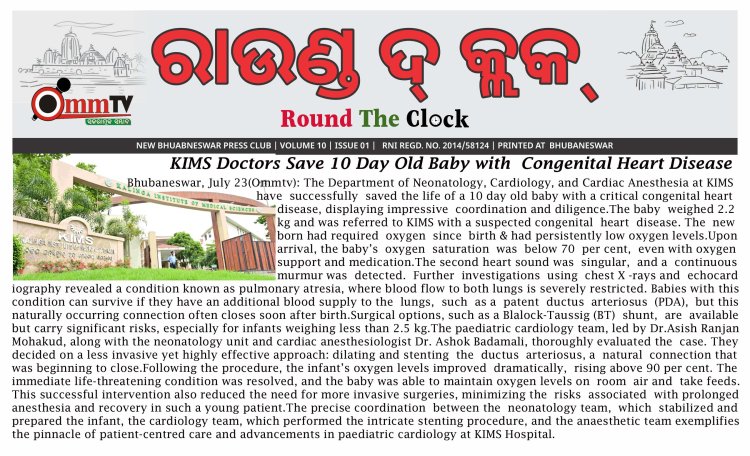KIMS Doctors Save 10 Day Old Baby with Congenital Heart Disease : Ommtv Round The Clock
KIMS Doctors Save 10 Day Old Baby with Congenital Heart Disease : Ommtv Round The Clock

KIMS Doctors Save 10 Day Old Baby with Congenital Heart Disease : Ommtv Round The Clock
Bhubaneswar, July 23: The Department of Neonatology, Cardiology, and Cardiac Anesthesia at KIMS have successfully saved the life of a 10-day-old baby with a critical congenital heart disease, displaying impressive coordination and diligence.The baby weighed 2.2 kg and was referred to KIMS with a suspected congenital heart disease. The newborn had required oxygen since birth and had persistently low oxygen levels. Upon arrival, the baby’s oxygen saturation was below 70 per cent, even with oxygen support and medication.The second heart sound was singular, and a continuous murmur was detected. Further investigations using chest X-rays and echocardiography revealed a condition known as pulmonary atresia, where blood flow to both lungs is severely restricted. Babies with this condition can survive if they have an additional blood supply to the lungs, such as a patent ductus arteriosus (PDA), but this naturally occurring connection often closes soon after birth.Surgical options, such as a Blalock-Taussig (BT) shunt, are available but carry significant risks, especially for infants weighing less than 2.5 kg.The paediatric cardiology team, led by Dr. Asish Ranjan Mohakud, along with the neonatology unit and cardiac anesthesiologist Dr. Ashok Badamali, thoroughly evaluated the case. They decided on a less invasive yet highly effective approach: dilating and stenting the ductus arteriosus, a natural connection that was beginning to close.Following the procedure, the infant’s oxygen levels improved dramatically, rising above 90 per cent. The immediate life-threatening condition was resolved, and the baby was able to maintain oxygen levels on room air and take feeds. This successful intervention also reduced the need for more invasive surgeries, minimizing the risks associated with prolonged anesthesia and recovery in such a young patient.The precise coordination between the neonatology team, which stabilized and prepared the infant, the cardiology team, which performed the intricate stenting procedure, and the anaesthetic team exemplifies the pinnacle of patient-centred care and advancements in paediatric cardiology at KIMS Hospital.

କିମ୍ସରେ ୧୦ଦିନ ଶିଶୁର ସଫଳ ହୃଦ୍ ଅସ୍ତ୍ରୋପଚାର
ଭୁବନେଶ୍ୱର,୨୩ ।୭: କଳିଙ୍ଗ ଇନ୍ଷ୍ଟିଚ୍ୟୁଟ୍ ଅଫ୍ ମେଡ଼ିକାଲ୍ ସାଇନ୍ସେସ୍(କିମ୍ସ)ର ଡାକ୍ତରମାନେ ଜନ୍ମଜାତ ହୃଦରୋଗର ଶିକାର ଜଣେ ୧୦ଦିନର ଶିଶୁର ଜୀବନ ରକ୍ଷା କରିବାରେ ସଫଳ ହୋଇଛନ୍ତି। କିମ୍ସର ନବଜାତ ଶିଶୁରୋଗ ବିଭାଗ, ହୃଦରୋଗ ଏବଂ ହୃଦରୋଗ ନିଶ୍ଚେତକ ବିଭାଗ ଡାକ୍ତରଙ୍କ ସମନ୍ୱିତ ପ୍ରଚେଷ୍ଟା ଯୋଗୁଁ ଏହା ସମ୍ଭବ ହୋଇଛି। ୨.୨ କିଲୋଗ୍ରାମ ଓଜନ ଥିବା ଶିଶୁଟି ଜନ୍ମଜାତ ହୃଦରୋଗ ସନ୍ଦେହରେ ରେଫର ହୋଇ କିମ୍ସକୁ ଆସିଥିଲା। ଶିଶୁଟି ଜନ୍ମରୁ ଅକ୍ସିଜେନ୍ ଆବଶ୍ୟକ କରୁଥିଲା ଏବଂ ତାର ଅକ୍ସିଜେନ୍ ସ୍ତର କ୍ରମାଗତ ଭାବେ କମ୍ ରହୁଥିଲା। ଶିଶୁଟି ହସ୍ପିଟାଲ୍କୁ ଆସିବା ବେଳେ ଅକ୍ସିଜେନ୍ ସପୋର୍ଟ ଓ ଔଷଧ ପ୍ରୟୋଗ ସତ୍ତ୍ୱେ ତାର ଅକ୍ସିଜେନ୍ ସାଚ୍ୟୁରେସନ୍ ୭୦ ପ୍ରତିଶତରୁ କମ୍ ରହୁଥିଲା। ଶିଶୁଟିର ସେକେଣ୍ଡ ହାର୍ଟ ସାଉଣ୍ଡ ସିଙ୍ଗୁଲାର ଥିବାବେଳେ କ୍ରମାଗତ ଭାବେ ଅସ୍ୱାଭାବିକ ଶବ୍ଦ ହେଉଥିବା ଜଣାପଡ଼ିଥିଲା। ପୁନର୍ବାର ଛାତି ଏକ୍ସ-ରେ ଏବଂ ଇକୋ-କାର୍ଡ଼ିଓଗ୍ରାଫିରୁ ଶିଶୁଟିର ପଲ୍ମୋନାରୀ ଆଟ୍ରେସିଆ ସ୍ଥିତି ଜଣାପଡ଼ିଥିଲା। ଏଥିରେ ଉଭୟ ଫୁସ୍ଫୁସ୍କୁ ରକ୍ତ ସଞ୍ଚାଳନ ଗମ୍ଭୀର ଭାବେ ବାଧିତ ହୋଇଥାଏ। ଏଭଳି ସମସ୍ୟା ଥିବା ଶିଶୁଙ୍କ କ୍ଷେତ୍ରରେ ଯଦି ସେମାନଙ୍କ ଫୁସ୍ଫୁସ୍କୁ ପେଟେଣ୍ଟ ଡ଼କ୍ଟସ୍ ଆର୍ଟେରିଓସସ୍(ପିଡ଼ିଏ) ଭଳି ଅତିରିକ୍ତ ରକ୍ତ ସଞ୍ଚାଳନ ରହିଥାନ୍ତା ତେବେ ସେମାନଙ୍କ ଜୀବନ ରକ୍ଷା ହୋଇପାରନ୍ତା। କିନ୍ତୁ ପ୍ରାକୃତିକ ଭାବେ ହେଉଥିବା ଏହି ସଂଯୋଗ ସାଧରଣତଃ ଜନ୍ମର ତୁରନ୍ତ ବାଦ୍ ବନ୍ଦ ହୋଇଯାଇଥାଏ। ତେବେ ଏଥିପାଇଁ ବ୍ଲାଲକ୍-ଟାସିଂଗ୍ (ବିଟି) ସଣ୍ଟ ଭଳି ଅନେକ ସର୍ଜିକାଲ୍ ବିକଳ୍ପ ରହିଛି। କିନ୍ତୁ ଏ କ୍ଷେତ୍ରରେ ବିଶେଷକରି ୨.୫ କିଲୋଗ୍ରାମ ଓଜନରୁ କମ୍ ଓଜନର ନବଜାତ ଶିଶୁଙ୍କ ପାଇଁ ଏସବୁ ସର୍ଜିକାଲ୍ ବିକଳ୍ପ କାର୍ଯ୍ୟକାରୀ କରିବାରେ ଅଧିକ ବିପଦ ଆଶଙ୍କା ରହିଥାଏ। କିମ୍ସ ହସ୍ପିଟାଲ୍ର ନବଜାତଶିଶୁ ବିଭାଗ ସମେତ ଡା. ଆଶିଷ ରଞ୍ଜନ ମହାକୁଡ଼ଙ୍କ ନେତୃତ୍ୱରେ ଶିଶୁ ହୃଦରୋଗ ଟିମ୍ ଓ ହୃଦ୍ ନିଶ୍ଚେତକ ବିଶେଷଜ୍ଞ ଡ଼ା. ଅଶୋକ ବଡ଼ମାଳି କେସ୍ଟିର ଟିକିନିଖି ତର୍ଜମା କରି ଶିଶୁଟିର ହୃତପିଣ୍ଡରେ ବନ୍ଦ ହେବାକୁ ଯାଉଥିବା ପ୍ରାକୃତିକ ସଂଯୋଗ ଡ଼କ୍ଟସ୍ ଆର୍ଟିରିଓସସକୁ ଡାଇଲେଣ୍ଟି କରି ଷ୍ଟେଣ୍ଟ ଲଗାଇଥିଲେ। ଏହି ପ୍ରକ୍ରିୟା ପରେ ଶିଶୁର ଅକ୍ସିଜେନ୍ ସ୍ତରରେ ଆଶାତୀତ ସୁଧାର ଆସିଥିଲା ଏବଂ ଅକ୍ସିଜେନ ସ୍ତର ୯୦ ପ୍ରତିଶତକୁ ବଢ଼ିଥିଲା। ଶିଶୁଟିର ଜୀବନ ପ୍ରତି ଥିବା ବିପଦ ତୁରନ୍ତ ଦୂର ହେବା ସହ ଶିଶୁଟି ସାଧାରଣ ବାୟୁଚଳାଚଳ କ୍ଷେତ୍ରରେ ନିଶ୍ୱାସପ୍ରଶ୍ୱାସ ନେବା ଓ ସାଧାରଣ ଖାଦ୍ୟ ଗ୍ରହଣ କରିପାରିଥିଲା। ଏହି ସଫଳ ପ୍ରକ୍ରିୟା ଅଧିକ ଯନ୍ତ୍ରଣାଦାୟକ ଅସ୍ତ୍ରୋପଚାରର ଆବଶ୍ୟକତାକୁ ହ୍ରାସ କରି ପାରିଛି। ଏହାଦ୍ୱାରା ଅଧିକ ସମୟ ଧରି ନିଶ୍ଚେତକର ପ୍ରଭାବ ସହ ଜଡ଼ିତ ଅନ୍ୟାନ୍ୟ ବିପଦ ଆଶଙ୍କା ହ୍ରାସ କରାଯାଇପାରିଛି।


















